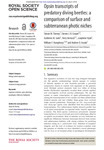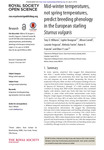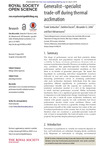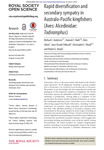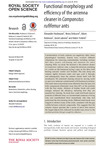Search
Now showing items 11-20 of 80
New evidence on the tool assisted hunting exhibited by chimpanzees
(2015)
For anthropologists, meat eating by primates like chimpanzees (Pan troglodytes) warrants examination given the emphasis on hunting in human evolutionary history. As referential models, apes provide insight into the evolution ...
Opsin transcripts of predatory diving beetles
(2015)
The regressive evolution of eyes has long intrigued biologists yet the genetic underpinnings remain opaque. A system of discrete aquifers in arid Australia provides a powerful comparative means to explore trait regression ...
Mid winter temperatures, not spring temperatures, predict breeding phenology in the European starling Sturnus vulgaris
(2015)
In many species, empirical data suggest that temperatures less than 1 month before breeding strongly influence laying date, consistent with predictions that short lag times between cue and response are more reliable, ...
Generalist specialist trade off during thermal acclimation
(2015)
The shape of performance curves and their plasticity define how individuals and populations respond to environmental variability. In theory, maximum performance decreases with an increase in performance breadth. However, ...
Rapid diversification and secondary sympatry in Australo-Pacific kingfishers
(2015)
Todiramphus chlorisis the most widely distributed of the Pacific’s ‘great speciators’. Its 50 subspecies constitute a species complex that is distributed over 16 000km from the Red Sea to Polynesia. We present, to our ...
High atmospheric temperatures and ‘ambient incubation’ drive embryonic development and lead to earlier hatching in a passerine bird
(The Royal Society, 2016)
Tropical and subtropical species typically experience relatively high atmospheric temperatures during reproduction, and are subject to climate-related challenges that are largely unexplored, relative to more extensive work ...
Males migrate farther than females in a differential migrant: an examination of the fasting endurance hypothesis
(The Royal Society, 2014)
Patterns of migration including connectivity between breeding and non-breeding populations and intraspecific variation in the distance travelled are important to study because they can affect individual fitness and population ...
Tiarajudens eccentricus and Anomocephalus africanus, two bizarre anomodonts (Synapsida, Therapsida) with dental occlusion from the Permian of Gondwana
(The Royal Society, 2015)
Anomodontia was a highly successful tetrapod clade during the Permian and the Triassic. New morphological information regarding two bizarre basal anomodonts is provided and their palaeoecological significance is explored. ...
Functional morphology and efficiency of the antenna cleaner in Camponotus rufifemurants
(The Royal Society, 2015)
Contamination of body surfaces can negatively affect many physiological functions. Insects have evolved different adaptations for removing contamination, including surfaces that allow passive self-cleaning and structures ...
Sexual reproduction with variablemating systems can resist asexuality in a rock–paper–scissors dynamics
(The Royal Society, 2015)
While sex can be advantageous for a lineage in the long term, we still lack an explanation for its maintenance with the twofold cost per generation. Here we model an infinite diploid population where two autosomal loci ...


